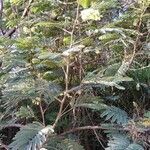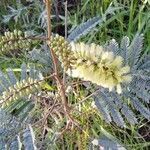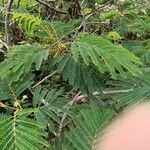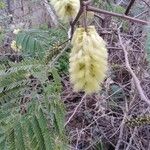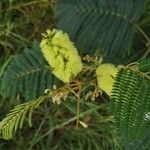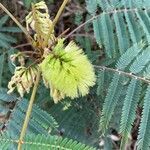Evergreen, unarmed tree or shrub, 2.4-15.0 m high. Leaves bipinnate, rachis with a conspicuous gland just below junction of top pinna pair; golden-hairy, becoming glabrous. Stipules linear, caducous. Inflorescences of bottlebrush-like, pedunculate racemes, axillary. Flowers bisexual, pedicellate, usually pubescent, subtended by bracts. Calyx gamosepalous, 5-valvate. Corolla gamopetalous, 5-valvate. Stamens many, united into a tube at base; anthers quadrangular, minute, opening by 2 slits. Ovary solitary. Flowering time June-Aug. Pod brown, chartaceous, flat, straight, not segmented, dehiscent along both sutures. Seeds subcircular-elliptical to oblong, flat to convex.
A small slender tree. It grows up to 6-10 m tall and spreads 2-8 m across. The small branches are slightly ribbed. The leaves are feather like. They are twice divided. There are many small leaflets. The flowers are small and creamy yellow. They occur in large numbers. The stamens are long. The flowers occur in dense spikes in the axils of leaves. The spikes are 10 cm long. The fruit are long, flat, brownish pods. They are 8-12 cm long. They contain many black seeds. There are 6-12 seeds.
Evergreen shrub or small tree, 4-6 m. Leaves bipinnate, with elongated gland midway along petiole. Flowers in cylindrical spikes, cream-coloured. Pods flattened, oblong-apiculate.
For description of taxon occurring in Australia see Paraserianthes lophantha (Willd.) I.C.Nielsen subsp. lophantha.
